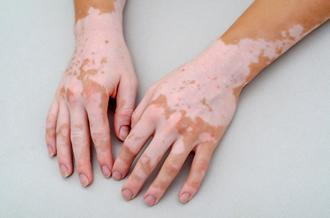
According to the National Vitiligo Foundation, around 70 million people around the world have vitiligo, an autoimmune disorder that causes white patches of skin. This condition is not contagious and cannot be spread from person to person, but the white patches can be a source of embarrassment or isolation for some patients. If you are living with vitiligo, or know someone who is, a dermatologist can help you determine the best treatment options for improving the appearance of vitiligo.
How is vitiligo treated?
There is currently no cure for vitiligo but that doesn’t mean that there aren’t ways to target and add pigment back into these depigmented patches of skin. Some of these treatment options include:
UVB Light Therapy
This is one of the oldest and most commonly used treatment options for vitiligo, which exposes areas of the body to light therapy multiple times a week. This narrow-band light therapy works by triggering the production of melanocytes, a skin cell responsible for producing pigmentation in the skin.
Topical Medications
Various topical creams can repigment the skin. Your dermatologist will look at the size and location of your vitiligo patches to determine the best topical medications for the job. Common topical medications include corticosteroids, calcineurin inhibitors, calcipotriene, and depigmentation medications.
Steroids are topical anti-inflammatories that can slow vitiligo and allow the body to produce more melanocytes. It can take up to a month to start seeing results. When steroids aren’t the ideal option, which is particularly common if a patient has patches of vitiligo in more sensitive areas such as the genitals or lips, your dermatologist may recommend calcineurin inhibitors.
If the majority of your body contains vitiligo patches, the best option may be to lighten the rest of your skin to reduce the appearance of these depigmented patches. This can be done with a topical depigmentation medication or light therapy. Medications are often recommended in conjunction with light therapy, but if light therapy isn’t being used then your dermatologist may recommend two or more medications to be used at the same time.
You don’t have to deal with vitiligo alone. A dermatologist can be the best medical specialist for helping you treat and manage your vitiligo symptoms. To learn more or to schedule an evaluation, call your dermatologist today.
